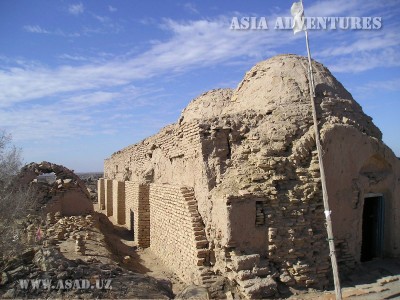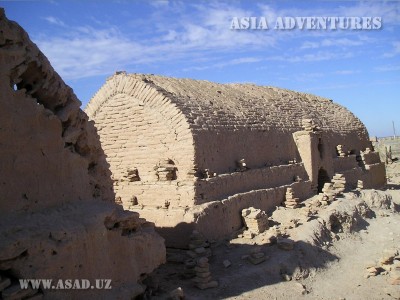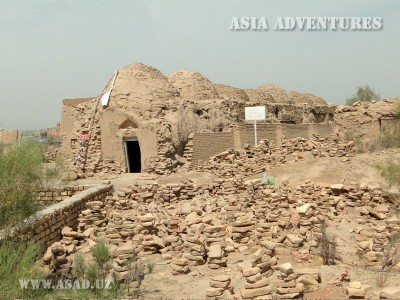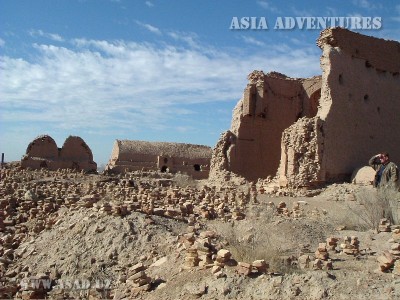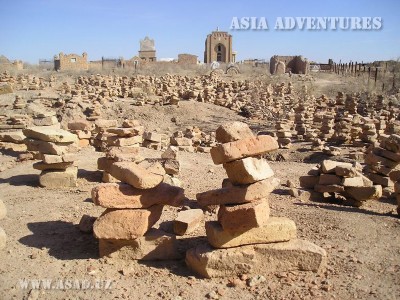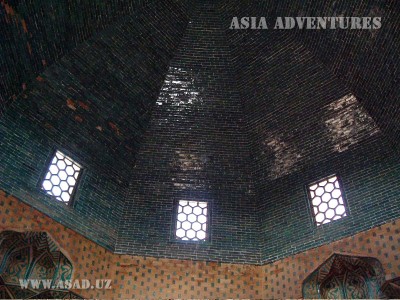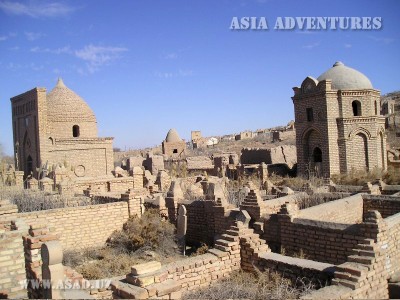
Mizdahkan (Mizdahan, Mizdakhan) is a major architectural and cultic complex and one of Karakalpakstan’s most interesting tourist objects. Mizdahkan is situated about 20 km from Nukus, the capital of the Republic of Karakalpakstan, stretching along the road to Kunya-Urgench. The complex was founded over 2 thousand years ago. Situated on three high hills, it currently ranks as the oldest cemetery in Uzbekistan. However, it is not a cemetery in the usual sense – a place where mortal humans find their last refuge. The site is full of mysteries and mysticism and to this day remains a place of pilgrimage.
The complex comprises several sections, including a citadel, residential area and necropolis. The ancient settlement sprang up on the western hill in about the 4th century BC. Later it was destroyed by fire, and in the Kushan period a new city was built on the site of the old one. Archaeological finds made at Mizdahkan testify to the city’s activity between the 5th and 8th centuries AD, with a series of public buildings constructed in this period. The 9th-11th centuries became a period of revival for Mizdahkan, and at this very time a well fortified citadel was built. Burial rituals also underwent some changes, which meant Islam began to prevail in the region. The bodies were not any longer left in the open air until they were buried in urns, but were interred in conformity with the Islamic rules. The spread of Islam resulted in a number of new monumental mausoleums and mosques in Mizdahkan, but the Mongol invasion in the early 13th century forced its people to leave the area for a short time. In the late 13th century a new small town with bazaars and craftsmen’s workshops was founded below the old city. The use of baked bricks and facing tiles and the ornamentation of walls indicate that architecture was on a high level in that period. Medieval Mizdahkan was a prosperous craft centre situated on a trade route to Kunya-Urgench. The city was destroyed by Tamerlane in his campaign to Kunya-Urgench in 1388.
The necropolis features a number of graves of unknown persons. Some of them are holy graves with a number of rituals and legends associated with them.
A construction known as the ‘world clock’ can be found on the site. This is not the traditional clock we see all around. It is a building, which is reported to have been used first as a madrasah and then as a mausoleum, when one of the local holy persons was buried there. Why is it a clock, then? And a ‘world clock’ at that? There is a belief that each year the building misses one brick in its brickwork. And when the brickwork collapses, that will be the end of the World. Currently there is about one third of the construction missing. It is easy to calculate that the lifespan of the humanity is around 3,000 years, which means that the world will come to an end one thousand years after 2012, the date prophesied by the Incas.
There are more beliefs associated with the construction, however. A person who erects a column using seven of the stones that have fallen off the structure and makes a wish will definitely have it come true. Such columns can be seen all over the area around the building. Obviously, there are more people who thus want their wishes to come true than there are stones. So disassembling other’s columns in order to create one’s own is allowed. The only condition is that the stones must not be taken away. It is believed to have very bad consequences.
So why does the column require 7 stones, and not 8, 9 or 4? This is connected with Mizdahkan’s other shrine, the Shamun-Nabi Mausoleum. Shamun-Nabi is a holy person deeply revered in Central Asia. He was an epic Muslim hero, a giant strong man who, according to legend, was locked in combat with a heathen from the neighbouring Gyaur-Kala (the fortress of fire worshippers). He used to help people a lot. After his death he is believed to have been buried in a mausoleum with seven domes. This corresponds with the number of daughters he had. So erecting a pillar a person appeals to Shamun-Nabi. There is a tomb stone 25 m long within the mausoleum, which was believed to keep the man’s corpse. But… when archaeologists opened the grave, they found it empty.
The Jumart Kasab or Zhomard Kassal (‘butcher Jumart’) Shrine on the top of the eastern hill might be a dahma (tomb). The lower mound enclosed in a rectangular stone barrier is connected with a local legend. Mound Jumart was, probably, named so after a rich person that lived in the area many years ago. When famine came he used to distribute meat to local people for free to save them from starvation. This originated a belief that if the population of livestock decreased because of diseases or lack of food, herds should be driven to the hill and sent around it seven times to scare off ill luck. Right there on the hill you can find dolls. They are brought there by women who cannot bring a child and visit the place each Thursday at dawn. Such women must ascend the hill, turn their face to the ‘world clock’ and do seven rolls down the hillside. We do not know whether or not this ritual helps, but tourists do like watching this action.
There is another structure – the ruined Yerejeb (Yerezhep) Caliph Mausoleum dated to the 11th century. The tomb constructed of mixed mud and baked bricks features a fine architectural design. There is a layer of reeds in the foundations to make the building earthquake-proof.
On the top of the hill there is a 12th-14th - century underground mausoleum – a type of structure unusual for the region. Stone steps lead down into the building. The mausoleum’s central room is square and has three deep niches and a shallow one. An arch in the room’s western wall leads to a smaller room roofed with an octagonal dome and faced with blue glazed bricks. Two dark vaulted rooms adjoin the main hall from the north. Finely painted plant ornaments are coated with delicately blue substance, which makes up a perfect harmony with the pinkish-yellow terracotta background. The walls and arches are faced with bricks decorated with fretted majolica patterns in the form of a ‘bow’. In the middle of the mausoleum there is a whole tomb decorated with majolica with writings in Persian. This monument is known among people as the Nazlymkhan-Sulu (Mazlumkhan-Sulu) Mausoleum named so after a beautiful young girl, the daughter of a local ruler.

 Centralasia Adventures
+998712544100
Centralasia Adventures
+998712544100




